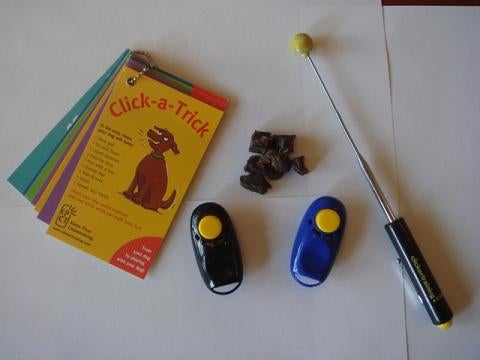Charging The Clicker
Making The Clicker Relevant & Motivating To Your Dog
Clickers are a brilliant tool for us dog trick trainers. I can't imagine teaching tricks without one - they make the process far more clear, precise and simple for our dogs.
Initially though, a clicker means nothing to your dog. That's why we need to charge the clicker. To charge up the clicker we pair the "click" with an object that already has a built in meaning to your dog - yummy treats.
When charging the clicker we build an association between the clicker (conditioned reinforcer) and the tasty treats (primary reinforcer). When the clicker is "charged" the clicker and the treats take on a similar meaning or value from your dog's perspective.
Watch as I Teach Macy, my Shih-Tzu the Value of the Clicker
General Rules To Follow When Charging The Clicker
- It's important to determine your dog's very favorite treats. The treats you use serve as motivation to your dog. My dogs love cheese, liver treats and pieces of hotdog - try to find the food that is most motivating to your dog.
- When charging the clicker your sole focus should be on pairing the clicker with the treats. Try to charge the clicker in different locations around your house and when your dog is in different positions. This is so your dog simply concentrates on the click and treat rather than where he is and what he is doing at the time. We will begin to shape behaviors with the clicker before long - but not just yet.
- A treat must always follow the click - that's the deal we make with our dogs, don't break it.
Why Use A Training Clicker Anyway?
Many people seem to be skeptical about using clickers - at least at first anyway. My advice would be to just give it a go for yourself and draw your own conclusions.From my perspective I believe clickers are a fantastic tool. A clicker provides clear and distinct feedback to your dog. Clickers are sometimes called "event markers" because when you click you are communicating to your dog that "what you just did earned you a click". It's a precise way of pinpointing a behavior to your dog and also signals that a treat is on its way.
The best thing about clicker training is that it works - pure and simple.
How Long Does It Take To Charge The Clicker?
Typically you will have the clicker charged in just a few short sessions. Most dogs catch on very quickly. If it takes you and your dog more than a few sessions that's ok too - there's no set time-frame. [google_ad:DOTR_CMS_468x60_InArticle2]
Does The Clicker Work With All Dogs?
In my experience, yes it does work on all dogs. Occasionally you hear the odd story about dogs who don't respond to the clicker or are spooked by it. If your dog is timid or fearful of the clicker you can soften the clicking noise by putting the clicker in your pocket or by covering it with a piece of cloth.Clicker training is not some gimmick or fad, it's based on proven scientific principles that have been used effectively in all types of animal training situations. If you'd like to learn more about clicker training I highly recommend this e-book - The 4 Secrets of Becoming a Supertrainer.
Do You Have To Use The Clicker And Treats All The Time?
The clicker and the treats are only used when building new behaviors (in this case, tricks). As soon as you have built and proofed a complete trick you can phase out the clicker and the treats.
How Do You Know When The Clicker Is Charged?
It's easier to see this happen with your own eyes rather than explain it to someone. Basically when the clicker is charged, you will know about it.When you bring the clicker out and your dog pricks his ears up, looks up at you expecting a treat, licks his lips, wags his tail in excitement or barks, you know that the clicker is charged and you are ready to start teaching some cool dog tricks.
Please consult the services of a Professional Dog Trainer, Behaviorist or Veterinarian before implementing any of the advice contained on this site.












 Your Privacy Choices
Your Privacy Choices